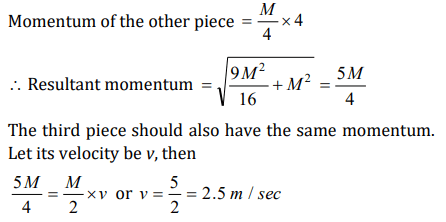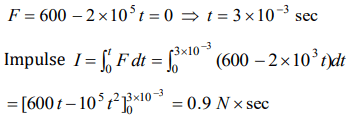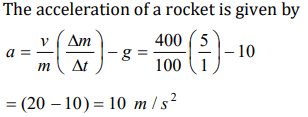1. A body of mass M at rest explodes into three pieces, two of which of mass M/4 each are thrown off in perpendicular directions with velocities of 3 m/s and 4 m/s respectively. The third piece will
be thrown off with a velocity of
a) 1.5 m/s
b) 2.0 m/s
c) 2.5 m/s
d) 3.0 m/s
Explanation:


2. The momentum of a system is conserved
a) Always
b) Never
c) In the absence of an external force on the system
d) None of the above
Explanation: In the absence of an external force on the system
3. A body of mass 0.25 kg is projected with muzzle velocity \[100 m s^{-1}\] from a tank of mass 100 kg. What is the recoil velocity of the tank
a) \[5 m s^{-1}\]
b) \[25 m s^{-1}\]
c) \[0.5 m s^{-1}\]
d) \[0.25 m s^{-1}\]
Explanation: Using law of conservation of momentum, we get
100 * v = 0.25 * 100
v = 0.25 m / s
4. A bullet is fired from a gun. The force on the bullet is given by \[F=600-2\times 10^{5}t\] , where F is in newtons and t in seconds. The force on the bullet
becomes zero as soon as it leaves the barrel. What is the average impulse imparted to the bullet
a) 9 Ns
b) Zero
c) 0.9 Ns
d) 1.8 Ns
Explanation:

5. A bullet of mass 0.1 kg is fired with a speed of 100 m/sec, the mass of gun is 50 kg. The velocity of recoil is
a) 0.2 m/sec
b) 0.1 m/sec
c) 0.5 m/sec
d) 0.05 m/sec
Explanation:

6. A bullet mass 10 gm is fired from a gun of mass 1kg. If the recoil velocity is 5 m/s, the velocity of the muzzle is
a) 0.05 m/s
b) 5 m/s
c) 50 m/s
d) 500 m/s
Explanation:

7. A rocket can go vertically upwards in earth's atmosphere because
a) It is lighter than air
b) Of gravitational pull of the sun
c) It has a fan which displaces more air per unit
time than the weight of the rocket
d) Of the force exerted on the rocket by gases
ejected by it
Explanation: Of the force exerted on the rocket by gases ejected by it
8. At a certain instant of time the mass of a rocket going up vertically is 100 kg. If it is ejecting 5 kg of gas per second at a speed of 400 m/s, the
acceleration of the rocket would be \[\left(g=10 m \diagup s^{2}\right)\]
a) \[20 m \diagup s^{2}\]
b) \[10 m \diagup s^{2}\]
c) \[2 m \diagup s^{2}\]
d) \[1 m \diagup s^{2}\]
Explanation:

9. A jet engine works on the principle of
a) Conservation of mass
b) Conservation of energy
c) Conservation of linear momentum
d) Conservation of angular momentum
Explanation: A jet engine works on the principle of Conservation of linear momentum
10. When a body is stationary
a) There is no force acting on it
b) The force acting on it is not in contact with it
c) The combination of forces acting on it balances each other
d) The body is in vacuum
Explanation: The combination of forces acting on it balances each other